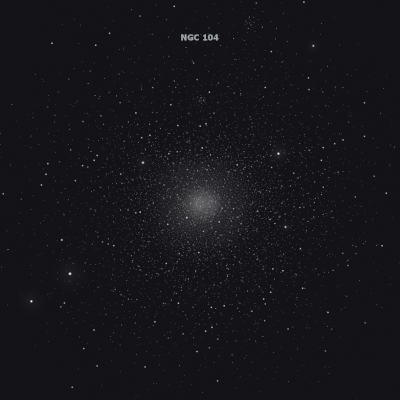47 Tuc Cluster
47 Tuc Cluster

Nicolas-Louis de Lacaille discovered the nebulous appearance of NGC 104 = Lac I-1 = D 18 = 47 Tucanae = h2322 in 1751-1752 with a 1/2-inch telescope at 8x during his expedition to the Cape of Good Hope. It appeared "like the nucleus of a fairly bright comet." He placed it in group I, consisting of nebulae without stars. The cluster was noted, though, as a "star" in Bayer's Uranometria, which was first published in 1603. The designation "47 Tuc" comes from Bode's extension of Flamsteed numbers to the southern constellations (these are not used today except for 47 Tuc and 30 Dor). With his 9-inch speculum reflector, James Dunlop logged "(47 Toucan, Bode) this is a beautiful large round nebula, about 8' diameter, very gradually condensed to the centre. This beautiful globe of light is easily resolved into stars of a dusky colour. The compression to the centre is very great, and the stars are considerably scattered south preceding and north following." His sketch in figure 1 of his catalogue shows a beautifully resolved, elongated cluster.
John Herschel observed it for the first time on 11 Apr 1834 and logged "the great cluster preceding the Nubecula Minor. Estimated dia of the denser portion 5'; of the whole (not, however, including loose stragglers) 8'. Stars 14..16 mag. and one of 12th mag N.p. the centre. Excessively compressed. (N.B. In a sweep below the pole, when of course owing to the low altitude much of the light was lost.)" His observation of 12 Aug 1834 reads: "A most glorious cluster. The stars are equal, 14th mag., immensely numerous and compressed. Its last outliers extend to a distance of 2 min, 16 sec in RA from the centre. It is compressed to a blaze of light at the centre, the diameter of the more compressed part being 30 arcsec in RA. It is at first very gradual, then pretty suddenly very much brighter in the middle. It is completely insulated. After it has passed, the ground of the sky is perfectly black throughout the whole breadth of the sweep. There is a double star 11th mag. preceding the centre (Pos. 226.5 - 6.5 arcsec in RA from centre of neb.)" On 21 Sep 1835 he wrote: "Fills the field with its stragglers, condensation in three distinct stages, first very gradually, next pretty suddenly, and finally very suddenly very much brighter in the middle up to a central blaze whose diameter in RA is 13.5 sec and whose colour is ruddy or orange-yellow, which contrasts evidently with the white light of the rest. The stars are all nearly equal (12..14 mag). A stupendous object." His final record of the object was on 5 Nov 1836: "A most magnificent globular cluster. It fills the field with its outskirts, but within its more compressed part, I can insulate a tolerably defined circular space of 90" dia wherein the compression is much more decided and the stars seem to run together; and this part I think has a pale pinkish or rose-colour." In his diary Herschel also refers to the "Rose coloured central mass".
300/350mm - 12" (6/29/02 - Bargo, Australia): While at Bargo, I observed 47 Tucanae for the first time. Though still very low in the sky the view was thrilling. At 186x, the globular filled the 26' field with an uncountable number of stars. Strongly concentrated to an intense, blazing core which was only partially resolved at a low elevation. The highly resolved outer halo extended ~25' in an irregular outline while the central halo was very symmetric. This is the most prominent naked-eye GC as so much of its light is concentrated into the central core and it lies in a sparse field with no other rivals other than the SMC.
400/500mm - 20" (7/8/02 - Magellan Observatory, Australia): this was the best view I had of 47 Tucanae during the week. At 212x, the entire 23' field was packed edge-to-edge with pinpoint stars and the blazing, intense core, which had a yellowish tint, was resolved into a mesmerizing dense mat of stars. The halo extended to at least 30'.
600/800mm - 30" (10/13/15 - OzSky): at 303x; the core was distinctly orange-yellow. In addition, I immediately noted a couple of obvious orange supergiants at the south edge of the core and in the outer halo on the east side.
30" (11/4/10 - Coonabarabran, 163x and 264x): absolutely stunning view in the 30" at 163x and 264x. Even in the 37' field of the 21mm Ethos, the stars appeared to fill the entire field, only thinning out near the edge. The pinpoint stars were amazingly packed, but increased in intensity to a relatively small, blazing core, which was plastered with resolved stars. The very center of the nucleus contained a small, intense knot overlaid with packed stars giving a strong impression of layers. I immediately noticed the core had a pale yellowish tint.
Naked-eye - easy 4th magnitude naked-eye blur just west of the SMC, seen many times from the southern hemisphere. Visible in a dark sky while very low in the sky and from suburban locations when higher in the sky.
Notes by Steve Gottlieb